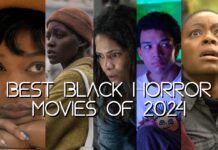I’ve frequently found myself wondering if horror fans are more prone to believing that the phenomena they see in their favorite films are real. I might be in the minority, but I don’t really believe in ghosts, demons, aliens, Sasquatches or giant mutant alligators living in the sewer, so I tend to roll my eyes at all these “ghost hunter” reality shows on TV nowadays.
Until recently, I honestly had never seen an episode all the way through; every time I start to watch, I get frustrated by the experience of watching people running around a dark building exclaiming how they see something or feel something that we the viewers never see or feel, and thus we just have to take their word for it. I don’t know why these shows are so popular, but then again, I also don’t understand why there are so so many competitive cooking shows or shows about vapid rich people’s staged interactions with one another. In short, it seems I’m out of touch with the pulse of society, so feel free to take this review with a grain of salt.
Demon House is a documentary from Zak Bagans, a paranormal investigator who hosts one of the longest-running ghost hunter shows, Travel Channel’s Ghost Adventures. I felt the need to go back to look at an episode of the series to compare it to the movie, and from my perspective, Demon House plays basically like an extended Ghost Adventures with more investigative work and fewer of those annoyingly unprovable first-hand experiences I complained about earlier — which is a good thing.
The movie investigates claims of demonic activity by Gary, Indiana resident Latoya Ammons and her family, which made headlines in 2014. In 2011, Ammons, her three children and her mother Rosa Campbell moved into a small, anonymous-looking rental home — hardly the sprawling, gothic mansion that’s the norm for cinematic haunted houses — and soon thereafter, they say they fell prey to ominous forces.
I’ll spare you all the details (noises, figures, possessions, etc.) but suffice it to say if these events happened to you in real life, you’d legit freak out. Of course, with secondhand stories like this (the Ammons family actually refused to take part in the film), it’s easy to dismiss it all as hearsay, but what makes these events more believable than typical unsubstantiated ghosts stories is that some of them were experienced by reputable public officials with no reason to lie on the family’s behalf. Most striking is the testimony of a Child Protective Services worker who claims to have witnessed (along with a nurse) the youngest Ammons son walk backwards up a wall like a possessed Spider-Man.
Although the Ammonses themselves didn’t partake in the documentary — purportedly out of fear, but it could also have something to do with the fact they sold the rights to their story to Hollywood filmmakers (indeed, Lee Daniels was at one time attached to make a film based on their ordeal, but when Relativity Studios went bankrupt in 2015, it seems the project died) — Bagans was able to find several people who’d experienced unexplained phenomena, including police officers, a priest, paranormal investigators and a family that lived in the house before the Ammons. A remarkable number of the folks who came in contact with the house, which became known as a “portal to Hell,” reportedly suffered misfortune shortly afterward, ranging from minor accidents to cancer, attempted suicide and straight-up murder.
The events surrounding the house are enough to chill you to the bone, so the attempts of Bagans and his film crew to capture anything on film seem fruitless and desperate by comparison. Their interpretations of blurry images and muffled sounds as something ominous feel forced and contrived — particularly when a pivotal moment with a shadowy figure is conveniently blurred by a camera’s ill-timed autofocus. We also have to simply take the word of Bagans and company that they “feel” bad when they’re in the house. One crew member in particular goes on a bit of a rampage, and while it’s fairly convincing, there’s nothing about it that can be substantiated.
That said, despite the red flags, the story of the haunting is inherently creepy enough — and the recreations are polished and well-done enough — that Demon House genuinely makes your skin crawl. Are Bagans’ overly slick “bro” demeanor and cheesy injury attorney voiceovers annoying? Sure, but he manages to cobble together some engaging interviews, second-hand accounts and ominous theories that all combine for an unnerving viewing experience. Whether the events are real, fake or part of some sort of mass delusion, it’s still fascinating to watch. It didn’t make me a believer, but as pure entertainment, it has an undeniable visceral impact.
One thing Bagans does that I appreciate is address the doubt that many viewers will naturally feel while watching his documentary. He takes time to lay out aspects of the story that could undermine its credibility, from the family profiting from a movie deal to an inspection that reveals potentially mind-altering levels of mold and carbon monoxide to a former resident seemingly offering to make up spooky encounters in exchange for money.
It’s unfortunate that it appears the horror movie based on the Ammons’ story will never get made, because as I’ve noted before, haunted house films from major studios are almost always lily-white affairs. The fact that the Ammons were an African-American family living in a lower-class rental home in an impoverished city would’ve immediately helped the film stand out from the pack, even before we get to the rather unprecedented extent to which the paranormal events were witnessed and documented.
Bagans even brings up an interesting theory that ties paranormal events directly to race and socioeconomics, stating, “I believe that certain environments can make demonic activity more likely. Poverty, high crime rates, murders can all contribute. Gary, Indiana, unfortunately, fits the bill, with over a third of its populating living below the poverty line in one of the highest murder rates in the country.” As harsh a reality as this is, it’s something horror movies have yet to adequately exploit. If ghosts tend to reside in places with sudden, violent deaths and emotional trauma, then the poorest, most crime-ridden sections of cities — typically the ones with large minority populations — should be some of the most haunted places around.


























